Yesterday I talked about the different types of parents at sports day. Today I thought I should talk about sports day itself.
My first taste of sports day happened my first few months in Japan. I was invited to attend in a way that made it seem as if my attendance was optional. However, as an Assistant Language Teacher working for the school board, I felt it was my duty to attend and, because I was still in the early glow of being in Japan, I was looking forward to attending. Then I got to school and one of my teachers said “I see you’re participating in the shototoshobugubugu and in the tsunabunatikihiki.” (not their real names) I went “huh?” and then figured out I was running the obstacle course and the taking part in the tug-o-war.
I’ve mentioned before that, partly thanks to acting, I have a bum knee and pointed out that, in fact, I had a limp and that I shouldn’t be involved in a running race, especially when jumping on and over stuff was involved. I also pointed out that I thought it was optional and didn’t understand why I was scheduled for events. They shrugged and said “ganbatte” which usually means “don’t give up” but in this case meant “Stop bitching and start stretching. You’ve got a race to run.”
The obstacle course involved moving 10 beans from one plate to another with chopsticks, hurdling a bar and crawling under another, crawling under a cargo net, running across a balance beam, fetching a piece of candy out of a tin of flour using only my face (not a joke), running around the track with the candy in my mouth and my face, eyes and lungs covered in flour, jumping on and over a vaulting horse, and then limping to the finish. The tug of war involved teachers and parents and went reasonably well for the other team.
What fascinated and horrified me the most, though, was the surprisingly violent nature of a lot of the sports. At one junior high school there was a tire grab where students rushed to several tires and tried to drag them back to their side. People got knocked down and stepped on and lots of skin was scraped off hands as tires were yanked away. In another event, called kibasen, three students carry a fourth whose job it is to grab a hat or bandana off the heads of rival students. Tempers flare, hair gets yanked out, some students abandon the pretext of grabbing the bandana and simply start pummeling their rivals.
At another junior high, groups of boys held up bamboo poles with flags on them and then formed pyramids that reinforced the flagpoles. Teams of girls then fought to pull down and or capture the opponent’s flag. This involved girls knocking girls down before they could reach the pyramid, girls jumping on the backs of boys in the pyramids to get more height, girls pulling girls down off the pyramid and dumping them in the dirt, and years of bad blood coming out. In once case, a girl was knocked out cold when got pushed backward off the pyramid and hit the back of her head square on the knee of another girl.
The school nurse saw the girl wasn’t moving, ran out into the game, which was still going on, slung the girl over her back and carried her away from the game without checking her once. Now, I appreciate roughhousing as much as the next person–and I’m still shocked that it’s the usually sedate Japanese doing these violent sports–but dragging an unconscious person off the field while play is still going on, causes even me to have a sense of decency.
Some schools have tamed some of the events–students usually grab large hats now instead of bandanas–but there’s still a lot of roughhousing to be had. Even in the elementary school events, my youngest had a bamboo pole grabbed out of her hand and was later dragged across the dirt by several stronger kids.


